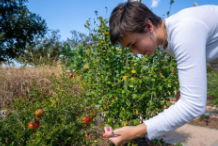Reminders
• Mound soil around potato plants to make sure tubers aren’t exposed. Sunlight hitting tubers will cause them to turn green.
• Check fruit trees for fruit. Multiple frost events this spring may have eliminated fruit on apricots, peaches and plums. Apples and pears may have been thinned but should bear a good crop through much of the state. If no fruit, sprays may not be needed except for the leaf disease on apples such as cedar-apple rust, apple scab and powdery mildew.
VEGETABLES
Cabbage Worms
This is the time of year we normally start seeing damage from cabbage worms. The imported cabbage worm is usually the first cabbage worm species to appear and is a fuzzy, elongated green worm. Larvae come from eggs laid by the white butterfly often seen flitting around the plants.
Early control is essential to reduce injury. BT (Bacillus thuringiensis) and spinosad (Monterey Garden Insect Spray, Captain Jack’s Dead Bug Brew) are effective organic products that are labeled for this pest. BT can be found in Dipel, Thuricide and other similar materials. Direct sunlight deactivates BT quickly so it is helpful to spray late in the day or on a cloudy day.
Conventional insecticides such as carbaryl (Sevin dust), malathion and methoxychlor are also effective but will kill natural enemies of these pests. Be sure to hit the underside of leaves where insects feed. Note that hitting the underside of leaves is easier when using a dust applied with a duster than when using a liquid spray. (Ward Upham)
‘Staggering’ Sweet Corn Planting
Sweet corn is one of those crops that is only “good” for a few days. If you want longer periods of production, consider staggering the planting. In other words, plant a small block, wait a period of time, and then plant the next block. Though it is tempting to follow a calendar schedule, such as planting a small block every week, it is better to use crop development as a trigger. If you plant on a calendar schedule, you may have noticed that later plantings often catch up with earlier ones. Instead, plant the next block of sweet corn when the previous one is one-half to one inch tall. (Ward Upham)
How to Make Tomato Cages
Tomato cages sold for home gardeners are often too wimpy for Kansas conditions. Fortunately, you can make your own cages from concrete reinforcing mesh (wire). This material is normally 5′ high with the “mesh” forming 6″ squares. The shortest rolls are usually 50′ long, but some lumber yards will cut off just the amount you need. Cages can be made in different sizes but I like a 2 foot diameter cage so I can space my tomatoes at 2 feet and then use a T-post to in between each pair to stabilize them in the wind. Figure 6.5 feet of mesh to complete one cage that is 2 feet in diameter. You will need to cut the mesh in order to make the cages. Small bolt cutters work well for this. Be careful when cutting as the mesh comes in rolls that will spring back into a cylinder as the last cut is made.
Count off 13 squares but cut each horizontal wire at the end of the 13 square. This will leave a series of 12 complete squares horizontally with prongs left on the 13th square. Use these prongs to make a cylinder by bending the prongs over the vertical wire on the first square. Tomatoes with large, rangy vines need all five feet of the mesh, but those with shorter, semi-determinate vines can get by with a shorter cage.
Also, cut off the bottom horizontal wire to leave prongs that can be pushed into the ground to help with stability. As mentioned above, a T-post will likely need to be driven near the cage. Tying the cage to the T-post can help prevent the cage from toppling in windy conditions.
These cages will last for years, but do take up a great deal of storage space when not in use. If you don’t have room for storage, there are heavy-duty tomato cages that will either fold flat or disassemble to make storage easier such as Texas Tomato Cages, Titan Tomato Cages and various others. Regardless, they may need to be staked if your garden is in a windy location. (Ward Upham)
FRUIT
Be on the Lookout for Peach Leaf Curl and Plum Pocket
Peach leaf curl is a fungus disease that causes developing peach leaves to become puckered and distorted and show a reddish-green hue. A similar disease called plum pocket may develop on American and sand hill plums. Plum pocket results in formation of distorted, light green, bladder-shaped fruit. Asian and European plums are not susceptible to the local strain of plum pocket. Unfortunately, it is too late to control any of these diseases with fungicides this year.
Trees that are severely infected with peach leaf curl are likely to lose many leaves. If trees are healthy, new leaves will grow. Indicators of a healthy tree are large, deep green leaves and last year’s growth being at least 18 to 24 inches long. If these tree vigor indicators are not present, especially if there was only 12 inches or less of growth last year, then a fertilizer application would be helpful if one has not been applied.
The fertilizer should be spread on the soil under the branch area. Apply 1 and 1/3 to 2 cups of a 13-13-13 fertilizer under the branch area. If a soil test indicates that only nitrogen is needed, use 1/3 to 1½ cups of nitrate of soda (16-0-0) instead of the 13-13-13. You may also substitute a high nitrogen fertilizer such as a 27-3-4, 30-5-4 or something similar for the 13-13-13, but use only half the amount used for nitrate of soda. The sooner fertilizer is applied, the more immediate benefit it will have in promoting new leaf growth.
Both peach leaf curl and plum pocket can be controlled with a single fungicide application applied this fall after leaf drop or early next spring before bud swell. An effective fungicide is chlorothalonil (Bravo, Daconil, Fertilome Broad-Spectrum Fungicide, Ortho Garden Disease Control and others). Be sure to cover the entire tree including the bark and trunk. (Ward Upham)
MISCELLANEOUS
Rabbits in the Garden
Rabbits in gardens are a perennial problem because of the wide variety of plants they can feed on. This time of year, they gravitate to young vegetables and flowers. But there are some vegetables that are rarely bothered including potatoes, tomatoes, corn, squash, cucumbers, and some peppers. The question is how do you protect other, more susceptible plants? Fencing provides a quick and effective control method. The fence does not need to be tall; 2 feet is sufficient for cottontails. But the mesh must be sufficiently fine (1 inch or less) so young rabbits will not be able to go through it. Support for the fence can be supplied by a number of products, but electric fence posts work well. Often fencing is not an acceptable choice because it affects the attractiveness of the garden.
Another type of barrier is a floating row cover. Though most often used to promote early growth by keeping plants warmer than normal, it can also help protect young plants from insects and wildlife.
Other ways to control rabbits including repellents, trapping and shooting. Repellents are often suggested for control but often do not last long and require frequent reapplication.
Also, many are poisonous and cannot be used on plants or plant parts destined for human consumption. Live traps can be used to collect and move the rabbits to a rural area several miles from where they were trapped. A number of baits can be used to entice the rabbit to enter the trap including a tightly rolled cabbage leaf held together with a toothpick. However, rabbits often avoid baits if other attractive food is available.
Another possibility is to use a motion-activated sprinkler. These are attached to a garden hose and release a short burst of water when motion is detected. Contech, Orbit and Havahart are suppliers and each is advertised as protecting up to at least 1,000 square feet. Shooting is another possibility when it is safe and legal to do so. (Ward Upham)
Moving Houseplants Outside for the Summer
It is often helpful to set many houseplants outside for the summer so they can recover from the low light levels endured during the winter months. As soon as night temperatures stay consistently above 55 degrees F, houseplants can be moved to their summer home.
Choose a spot that has dappled shade, is protected from the wind and is close to water. A porch or a spot that receives shade from trees or buildings will work well. Putting houseplants in full sun will cause the leaves to photooxidize or sunburn because the leaves have become adapted to low light levels inside the house. Where possible, sink the pots into the ground to help moderate root temperatures and reduce watering frequency.
If you have a number of plants, dig a trench 6 to 8 inches deep (or deeper if you have larger pots) and long enough to accommodate all of your plants without crowding. Place peat moss under and around the pots. Peat moss holds water, helps keep the pots cool and reduces evaporation from clay pots. About every two weeks, rotate the pots a quarter turn to break off any roots that have penetrated the peat moss surrounding the pot and to equalize the light received on all sides of the pot. Water as needed. If the potting soil is dry a half-inch deep in the pot, it is time to water. (Ward Upham)
Contributors: Ward Upham, Extension Associate
Division of Horticulture
1712 Claflin, 2021 Throckmorton
Manhattan, KS 66506
(785) 532-6173
For questions or further information, contact: wupham@ksu.edu OR cdipman@ksu.edu
This newsletter is also available on the World Wide Web at: http://hnr.k-state.edu/extension/info-center/newsletters/index.html
The web version includes color images that illustrate subjects discussed. To subscribe to this newsletter electronically, send an e-mail message to cdipman@ksu.edu or wupham@ksu.edu listing your e-mail address in the message.
Brand names appearing in this newsletter are for product identification purposes only. No endorsement is intended, nor is criticism implied of similar products not mentioned.
K-State Research and Extension is committed to making its services, activities and programs accessible to all participants. If you have special requirements due to a physical, vision or hearing disability, or a dietary restriction please contact Extension Horticulture at (785) 532-6173.
Kansas State University Agricultural Experiment Station and Cooperative Extension Service K-State Research and Extension is an equal opportunity employer. Issued in furtherance of Cooperative Extension Work, Acts of May 8 and June 30, 1914, as amended. Kansas State University, County Extension Councils, and United States Department of Agriculture
Cooperating, Ernie Minton, Dean.
Video of the Week: Stake and Weave Tomatoes
https://kansashealthyyards.org/all-videos/video/stake-and-weave-tomatoes





